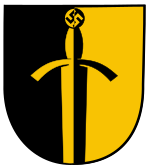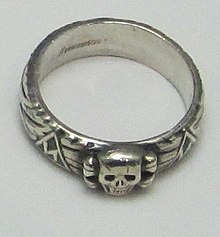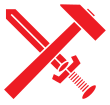| This article may need to be rewritten to comply with Misplaced Pages's quality standards. You can help. The talk page may contain suggestions. (March 2023) |
 The swastika was the first symbol of Nazism and remains strongly associated with it in the Western world.
The swastika was the first symbol of Nazism and remains strongly associated with it in the Western world.
The 20th-century German Nazi Party made extensive use of graphic symbols, especially the swastika, notably in the form of the swastika flag, which became the co-national flag of Nazi Germany in 1933, and the sole national flag in 1935. A very similar flag had represented the Party beginning in 1920.
Nazi symbols and additional symbols have subsequently been used by neo-Nazis.
Swastika
Main article: Swastika § Use in NazismThe Nazis' principal symbol was the swastika, which the newly established Nazi Party formally adopted in 1920. The formal symbol of the party was the Parteiadler, an eagle atop a swastika.
The black-white-red motif is based on the colours of the flags of the German Empire. This colour scheme was commonly associated with anti-Weimar German nationalists, following the fall of the German Empire. The Nazis denounced the black-red-gold flag of the Weimar Republic (the current flag of Germany).
Today, certain countries such as Austria, Brazil, China, France, Germany (see Strafgesetzbuch section 86a), Israel, Latvia, Lithuania, Poland, Russia, Ukraine and other countries have banned Nazi symbols and it is considered a criminal offence if they are displayed publicly for non-educational purposes. On August 9, 2018, Germany lifted the ban on the usage of swastikas and other Nazi symbols in video games. "Through the change in the interpretation of the law, games that critically look at current affairs can for the first time be given a USK age rating", USK managing director Elisabeth Secker told CTV. "This has long been the case for films and with regards to the freedom of the arts, this is now rightly also the case with computer and videogames."
Heraldry


 The ancient arms of Coburg (left) featured the head of Saint Maurice, a symbol looked down upon by the Nazi party. In 1934, it was replaced by a coat of arms featuring a sword with a swastika on the pommel (right). The original coat of arms was restored in 1945.
The ancient arms of Coburg (left) featured the head of Saint Maurice, a symbol looked down upon by the Nazi party. In 1934, it was replaced by a coat of arms featuring a sword with a swastika on the pommel (right). The original coat of arms was restored in 1945.
Under the Nazi regime, government bodies were encouraged to remove religious symbolism from their heraldry. Few German councils actually changed their often ancient symbols. Some, however, did, including Coburg, which replaced the Moor's head representing Saint Maurice on their arms with a sword and swastika, and Thuringia, which added a swastika to the paws of their lion.
Other symbols and insignia
Letters of the Armanen runes invented by Guido von List were used by the SS, particularly the Doppel Siegrune, based on the historical sowilo rune reinterpreted by List to signify 'victory' instead of the sun. Other Armanen runes used by the Nazis and subsequently by neo-Nazis include forms derived from Eihwaz, Tiwaz, Algiz and Othala.

The death's head appears on the SS-Ehrenring presented by Heinrich Himmler to favored members of the SS, and was used as an insignia by the Death's Head Units of the SS that administered the concentration camps.
Units of the Wehrmacht used insignia including the Wolfsangel
The Ahnenerbe research unit of the SS also used Wilhelm Teudt's neo-heathen Irminsul symbol.
Strasserism, a strand of Nazism with a Third Positionist ideology, used a crossed hammer and sword as its emblem.
Usages by neo-Nazi groups
Many symbols used by the Nazis have further been appropriated by neo-Nazi groups, including a number of runes; the so-called Black Sun, derived from a mosaic floor in Himmler's remodel of Wewelsburg; and the Celtic cross, originally a symbol used to represent pre-Christian and Christian European groups such as the Irish.
Neo-Nazis also employ various number symbols:
- 18, code for Adolf Hitler. The number comes from the position of the letters in the alphabet: A = 1, H = 8.
- 88, code for "Heil Hitler", a phrase used in the Nazi salute. Also used as a reference to the "88 Precepts", a manifesto written by white supremacist David Lane.
- 14, from the Fourteen Words coined by David Lane: "We must secure the existence of our people and a future for white children."
- 14 and 88 are sometimes combined with each other (i.e. 14/88, 8814, 1488). They are also sometimes depicted on dice.
In 1997, Wolfgang Fröhlich, a Holocaust denier and former district council member for the Freedom Party of Austria, alleged that Adolf Hitler's favorite food was egg dumplings (Eiernockerl). Some restaurants in Austria started advertising the dish as a "daily special" for the 20th of April, which is Hitler's date of birth, and although the allegation about the dish has never been historically confirmed, some neofascists began eating it as a symbolic food to celebrate Hitler's birthday.
Gallery
-
 The Parteiadler of the Nazi Party (1933–1945)
The Parteiadler of the Nazi Party (1933–1945)
-
 SS death's head insignia
SS death's head insignia
-
 Horizontally aligned Wolfsangel, used by the 2nd SS Panzer Division
Horizontally aligned Wolfsangel, used by the 2nd SS Panzer Division
-
 Vertically aligned Wolfsangel, used by the 4th SS Polizei Panzergrenadier Division
Vertically aligned Wolfsangel, used by the 4th SS Polizei Panzergrenadier Division
-
 Odal rune with feet, used by the 7th SS Volunteer Mountain Division (also used by the American-based "National Socialist Movement" from November 2016 until 2019)
Odal rune with feet, used by the 7th SS Volunteer Mountain Division (also used by the American-based "National Socialist Movement" from November 2016 until 2019)
-
 SS Doppel Siegrune, based on the sig Armanen rune, in turn based on the historical sowilo rune.
SS Doppel Siegrune, based on the sig Armanen rune, in turn based on the historical sowilo rune.
-
 Algiz rune
Algiz rune
-
 Iron Cross (1939 version)
Iron Cross (1939 version)
-
 A simplified version of the Celtic cross, as used by various neo-Nazi groups
A simplified version of the Celtic cross, as used by various neo-Nazi groups
-
 The broken sun cross used by the German Faith Movement and the 5th SS Panzer Division, also used by the Thule Society
The broken sun cross used by the German Faith Movement and the 5th SS Panzer Division, also used by the Thule Society
-
 The Hammer and Sword utilized by adherents of Strasserism
The Hammer and Sword utilized by adherents of Strasserism
-
 The Black Sun used by Esoteric Nazi circles and other neo-Nazi groups
The Black Sun used by Esoteric Nazi circles and other neo-Nazi groups
-
 A variation of the Black Sun used by Esoteric Nazi circles and other neo-Nazi groups
A variation of the Black Sun used by Esoteric Nazi circles and other neo-Nazi groups
See also
- Art in Nazi Germany
- Bans on Nazi symbols
- Communist symbolism
- Fascist symbolism
- List of German flags
- List of symbols designated by the Anti-Defamation League as hate symbols
- National symbols of Germany
- Nazi memorabilia
- Propaganda in Nazi Germany
- Rising Sun Flag
- Nazi symbolism in Taiwan
References
- "History of the Swastika". United States Holocaust Memorial Museum. Archived from the original on 12 April 2018. Retrieved 9 May 2018.
- ^ Hilmar Hoffmann, John Broadwin, Volker R. Berghahn. The Triumph of Propaganda: Film and National Socialism, 1933–1945. Berghahn Books, 1997. Pp. 16.
- Staff (9 August 2018). "Germany lifts ban on Nazi symbols in video games". The Telegraph. Archived from the original on 9 January 2019. Retrieved 9 January 2019.
- Chalk, Andy (9 August 2018). "Germany Lifts Ban on Swastikas in Videogames". PC Gamer. Archived from the original on 9 January 2019. Retrieved 9 January 2019.
- Slater, Stephen (2003). The Complete Book of Heraldry: An International History Of Heraldry And Its Contemporary Uses. London: Anness Publishing. p. 212. ISBN 0754810623.
- "Hate Symbols: Life Rune - From A Visual Database of Extremist Symbols, Logos and Tattoos". Anti-Defamation League. Archived from the original on 21 January 2013. Retrieved 23 April 2015.
- ^ "Hate Symbols: Othala Rune - From A Visual Database of Extremist Symbols, Logos and Tattoos". Anti-Defamation League. Archived from the original on 21 January 2013. Retrieved 23 April 2015.
- "Hate Symbols: Neo-Nazi Skull and Crossbones". Anti-Defamation League. Archived from the original on 2013-01-21. Retrieved 2008-12-17.
- "Wolfsangel". Anti-Defamation League. Archived from the original on 2008-12-17. Retrieved 2008-12-17.
- Wichert, Lasse (2018). Personale Mythen des Nationalsozialismus: Die Gestaltung des Einzelnen in literarischen Entwürfen. Genozid und Gedächtnis (in German). Wilhelm Fink. p. 154. ISBN 978-3-7705-6342-5.
- "Hate Number Symbols: 18". Anti-Defamation League. Archived from the original on 15 November 2012. Retrieved 23 April 2015.
- "Hate Number Symbols: 88". Anti-Defamation League. Archived from the original on 6 April 2018. Retrieved 20 March 2018.
- "Hate Number Symbols: 14 (words)". Anti-Defamation League. Archived from the original on 26 October 2012. Retrieved 23 April 2015.
- "Hate Number Symbols: 14/88". Anti-Defamation League. Archived from the original on 26 October 2012. Retrieved 23 April 2015.
- Willingham, A.J. (22 February 2017). "These are the new symbols of hate". CNN. Archived from the original on 20 March 2018. Retrieved 20 March 2018.
- Vessely, Rebecca (12 November 1996). "Germany restricts internet content". Wired. Archived from the original on 21 September 2020. Retrieved 30 August 2018.
- ^ "Some Austrians celebrated 4/20 by eating Hitler's favorite dish". The Jerusalem Post. 21 April 2016. Archived from the original on 22 April 2022. Retrieved 28 April 2022.
- Herbst, Hanna (20 April 2016). "Hitler-Verehrer servieren zur Feier des Tages Eiernockerl mit Salat" [Hitler's admirers serve Eiernockerl with salad to celebrate the day]. Vice (in German). Archived from the original on 31 August 2018. Retrieved 30 August 2018.
- "Hate Symbols: Neo-Nazi Skull and Crossbones". Anti-Defamation League. Archived from the original on 21 January 2013. Retrieved 23 April 2015.
- "Wolfsangel". Anti-Defamation League. Archived from the original on 21 January 2013. Retrieved 23 April 2015.
- Kovaleski, Serge; Turkewitz, Julie; Goldstein, Joseph; Barry, Dan (10 December 2016). "An Alt-Right Makeover Shrouds the Swastikas". The New York Times. Archived from the original on 12 December 2016. Retrieved 12 December 2016.
- "Hate Symbols: Celtic Cross". Anti-Defamation League. Archived from the original on 21 January 2013. Retrieved 23 April 2015.
